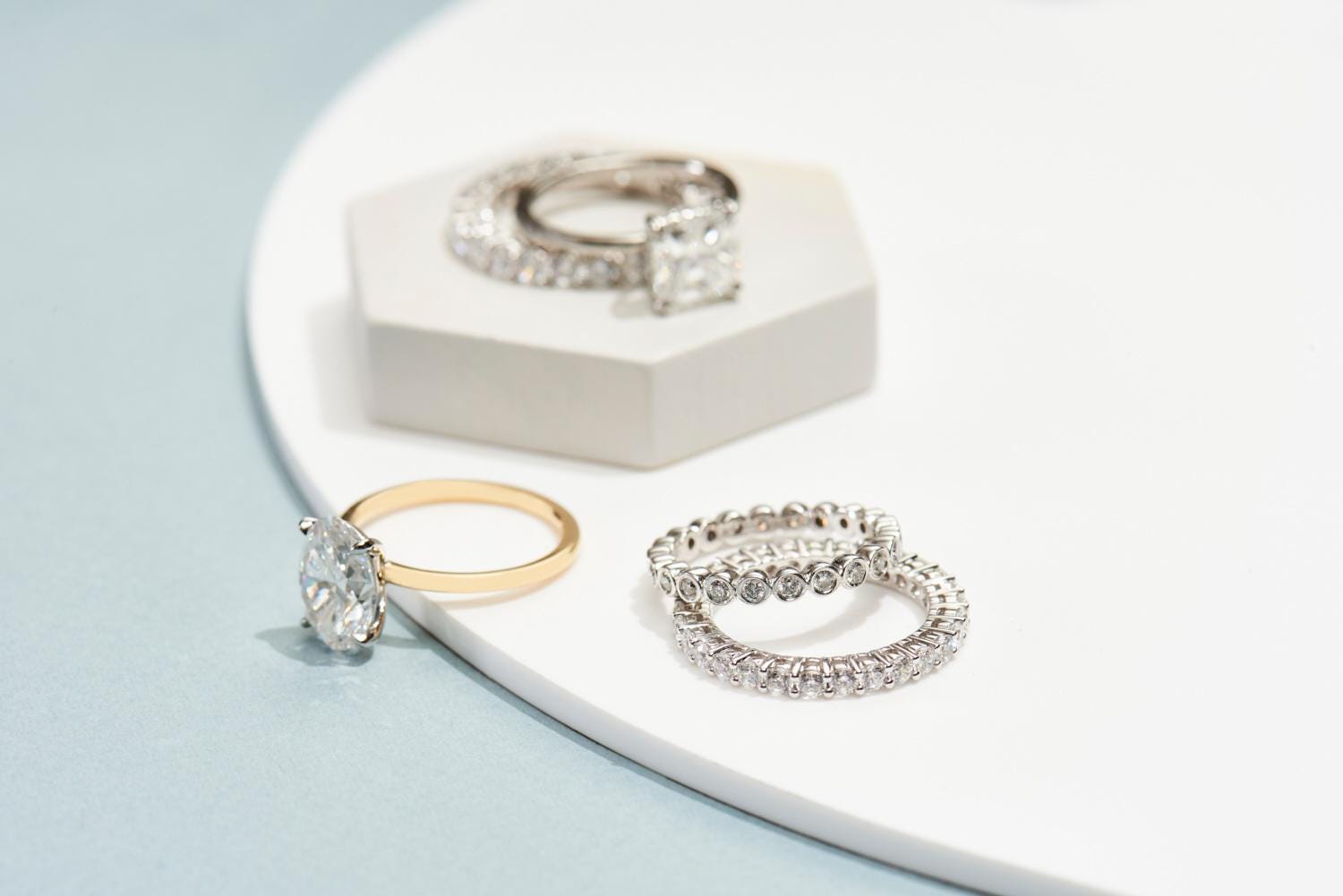
Diamonds are a couples’ best friend, according to The Clear Cut. Here, a few of the … [+]
The Clear Cut, a direct-to-consumer fine jewelry company specializing in bespoke engagement rings, has launched new technology that connects every client with one of the Gemological Institute of America’s diamond experts. The technology, which is called GEM by The Clear Cut allows the betrothed to have a more personal and intimate buying experience when shopping for a bespoke engagement ring and other wedding jewelry.
The company, whose goal is to create an elevated and streamlined shopping experience for all, reduced the amount of time it takes to convert customers by 40%, and whittled down the days from receiving diamond options to initial payment from an average of 13 days to 8 days, so the brand is closing sales much faster.
GEM allows clients to easily and quickly access a variety of diamonds curated for their budget and preferences, speak to a gemologist, leave comments and feedback, and ultimately find the perfect diamond engagement ring, all from the comfort of their own homes.
Clear Cut has an interesting back story. Cue the romantic meter and crank it up. Olivia Landau, founder and CEO of Clear Cut in 2013 met her husband and business partner, Kyle Simon at New York’s Gemological Institute of America.
“I come from a long line of diamond cutters and dealers on my dad’s side of the family, and my dad and my mom have their own antique jewelry business, so I kind of grew up around the industry,” Landau said. “I never thought I would go into it myself, but I decided after college to enroll and become a graduate gemologist. I really fell in love with diamonds and gem stones. I was also lucky enough to meet Kyle there.”
MORE FOR YOU
“I have a very different background,” Simon said. “I’m not a fourth generation diamond expert. When I graduated from college, I went to West Africa to Sierra Leone and worked in politics. From there, an opportunity presented itself to start a fair trade diamond mining company.
“I didn’t know much about diamonds at the time, so my investors sent me to GIA to study, which is where I met Olivia,” said Simon, who has an altruistic streak. “I then returned to Africa and worked on a venture around the ebola epidemic, which devastated Sierra Leone. After that, I returned to New York and went to Columbia for my Masters degree.
After completing her training at GIA, Landau took a pretty traditional employment route, working at Tiffany & Co.
Meanwhile, at Columbia at business school, a lot of Simon’s friends were at the age where they wanted to get engaged and knew he had a background in diamonds. “Everyone would always go to him and say, ‘Do you know a guy who can get me a good deal on a ring,’” Landau said. “I happened to be that guy.”
Landau helped educate Kyle’s classmates on everything diamond, assisting them with stone selection and creating custom rings. It was just a side hustle until she had an epiphany: “I realized that most people don’t know the first thing about buying a diamond. That led me to launch The Clear Cut as an educational blog for our friends. I started posting some designs on Instagram and that’s when it really took off. People asked me if I could create their rings and it turned into this accidental business that wasn’t intentional.”
When Simon was graduating from B-school, he realized that Landau’s side business had potential and that there must be some white space in the market if people were asking Landau to create engagement rings. The couple – who weren’t married themselves yet – applied to New York-based TechStars, an accelerator program, and was accepted in January of 2018. That’s when they quit their day jobs and started devoting all of their time to The Clear Cut.
“We launched our mission to be [our] generation’s jeweler for life,” Landau said. “We entered 2020 with a lot of momentum. We were known for selling engagement rings on social media and we wanted a systematic and scalable way to work with today’s customers, whose preferred mode of shopping was remote, even prior to the Covid-19 pandemic.
“We had a very good idea of how we wanted to build the process because it didn’t exist anywhere,” Simon said. “So right before the pandemic, we decided to start building our GEM software, which was a client-facing platform and an elevated experience for our bespoke clients. We also built some back end tools that would help us scale our production and inventory management.”
The site’s sales volume is not insignificant. “Since 2018, we’ve more or less doubled in our revenue every year,” Simon said. “We sell seven figures worth of diamonds a month, so tens of millions of diamonds over the last couple of years.”
Landau and Simon got married in June of 2019. “We started the business as boyfriend and girlfriend,” she said. “We got engaged and married through the process. We were selling engagement rings before we ourselves were engaged.”
The GEM portal with Kyle’s ring.
So what kind of ring does Landau have? “I got really lucky because my parents were in the industry,” she said. “When I was eight years old, I saw this Art Deco ring that my mom had in her inventory. I told her to save it for me because I loved it so much, and she said, ‘No, I’m not going to do that. Your husband has to pick out your ring.’
“She did save it for me, so when Kyle asked my parents for permission, she gave it to him,” Landau said. “It was very sentimental and a huge surprise because I wasn’t expecting it.” The 1920s ring consists of an Asher-cut diamond with a baguette. “The center stone is just about 3.25 carats, but it has a frame. I’m not sure how many carats the bagettes are.” Told that it may be bigger than the ring Megan Fox recently received from her fiance, Landau said, “She has two stones, so it’s a pretty big look.”
Launching online was prescient in hindsight. “Going into 2020, obviously Covid hit and all of a sudden every jewelry store in America was closed,” Simon said. “We really had to double down on this remote process and the investment in technology really paid off. We continued to roll out additional features and ways to make it a more elevated experience.
“Prior to the pandemic, if you wanted to buy an engagement ring you had several options,” Simon added. “You could shop an online marketplace with hundreds of thousands of options and no customer service, or you could go to an over-priced retail store that didn’t provide the best value, but at least you’d have an elevated experience. A third option was a family jeweler. We were trying to get that intimate fine jewelry experience through technology to everyone, regardless of where they lived and their price point.”
The Clear Cut’s process involves a number of steps, starting with the phone consultation with a GIA graduate gemologist, who assesses clients’ preferences. The Clear Cut creates a custom GEM portal, which contains all the information from the gemologist conversation as well as up to five loose diamonds. Clients choose their diamond through the portal. If they don’t see it among the curation, there are further discussions. “We want to get more and more specific until we land on the perfect one,” Landau said.
After clients pay a one-third deposit, ring design and creation begins. Every ring is made in New York using non-conflict diamonds. It usually takes about three to four weeks to create the ring. When it’s finished, clients receive a final ring video through the portal, pay the final balance and schedule shipment. They can download their insurance appraisal in the portal, too.
“On the back end of the GEM portal is inventory management and an integration for dynamic pricing of loose diamonds. “If prices increase in the market, it will autogenerate,” Simon said, adding, “a lot of the people we deal with are pretty old school and still do things with pen and paper, so we had to build the whole system to manage our production. Each piece generates a QR code that [liaises] with our vendors, so we know exactly where the ring is in the production process. We also have a quality control check list so we can make sure there are no bottlenecks in production.”
“We’re connecting our fine jewelry collection to the GEM portal so clients will be able to not only create custom rings, but purchase wedding bands, which are made to order,” Landau said. “Basically, what we want to do is democratize the private jewelry experience that doesn’t really exist now and connect with people all over the world with really high level of customer service.”







